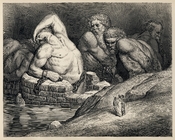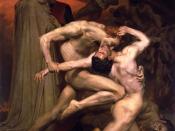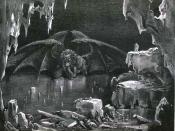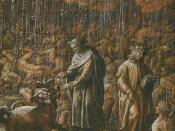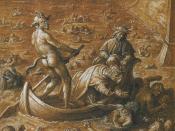Dante: Master of Horror Dante's Inferno was one of the earliest pieces of classical literary horror, introducing the now clichÃÂéd Hell of fiery terror, mangled souls, and horrifying demons. Modern literature and film have thrived on vomit-inducing description and eye-popping special effects, almost eliminating the need for using one's imagination. Dante, however, skillfully intertwined graphic imagery with thought-provoking substance, thus attracting the reader's appetite for gore and leaving him sufficiently haunted and terrified, as well. The wood of the Suicides in Canto XIII, and the painful metamorphosis of Thieves in Canto XXV, are two vivid examples of Dante's mastery of the art of horror.
The striking description and symbolism of the punishment administered to the Suicides in Canto XIII, clearly demonstrates the manipulation of imagery used in the Inferno. As the Canto begins and Dante and Virgil enter the second ring of the seventh circle, the scenery changes from the fiery crimson river of blood to that of ""æwoods unmarked/ By any path.
The leaves not green, earth-hued;/ The boughs not smooth, knotted and crooked-forked;/ No fruit, but poisoned thorns." (Canto XIII, lines 1-5, p. 101) Immediately, the reader is acquainted with a forest of darkness, and given a sense of uneasiness. The sudden change also represents the difference in the system of contra paso between those who inflicted violence upon others and those who inflicted violence on themselves. The world of the Suicides is one of darkness and desolation, quite contrary to the red-hot environment of the bloodthirsty murderers. The description of Dante innocently tearing a twig from one of the trees is even more chilling than that of the forest itself, and supposedly grabs the reader with horrifying surprise: ""æI reached my hand/ A little in front of me and twisted off/ One shoot of a mighty thorn bush- and it moaned,/'Why do you break me?'"æ As flames spurt at one side/ Of a green log oozing with sap at the other end,/ Hissing with escaping air, so that branch flowed/ With words and blood together- at which my hand/ Released the tip"æ" (Canto XIII, lines 29-32, 37-41, pp. 101, 103) At this point Dante reveals to the reader that the moans are actually coming from the trees, and elaborates upon their suffering with frightening personification. The thorn bush cries in pain, and oozes blood rather than sap, and the green log gasps for air as it's burned alive. The most unsettling aspect of Canto V, though, is not the graphic mutilation of the trees, but the allegorical implications of their anguish. Unlike most of the other souls in the Inferno, the Suicides have been forced to give up their human forms, as it stated in the Bible, because they didn't appreciate their bodies in life. Thus, they must suffer as something that exists enough to experience pain, but are void of free-will. Also, the reader must acknowledge that these damned souls inflicted all their suffering upon themselves. This, as well as the other punishments found in the Inferno, serves as a threatening warning to frighten the reader into abstaining from sin.
The fate of the Thieves in Canto XXV is equally as gruesome and poignant as that of the Suicides. Here, in the seventh pouch of the eighth circle of Hell, Dante lucidly depicts the transmutation of the Thieves' souls into serpents. The soul of Cianfa, in the form of a six foot long serpent, attacks Angello and initiates a ghastly mutation. First it the serpent clutched Angello, and ""æwith the middle feet it got/ A grip upon the belly, with each fore-limb/ It clasped and arm; it's fangs gripped both his cheeks;/ It spread its hind feet out to do thee same/ To both his thighs, extending his tail to flex/ Between them upward through to the loins behind." (Canto XXV, lines 51-56, p. 209) Next, ""æas if made/ Out of hot wax"æ" (Canto XXV, lines 59-60, p. 209), they began to melt together into an unintelligible mass of snake soul, so that ""æ neither could be construed"æ" (Canto XXV, line 61, p. 209) This mutation is illustrated with harsh, hideous detail, and is surely intended to disgust the reader. Not only do the two souls fuse in a particularly repulsive way, but the act of their fusion is portrayed as one of appalling bodily (and one may infer, sexual) assault. Then, as if this isn't enough, Dante further shocks the reader with a second metamorphosis. Here, a small black serpent strikes one of the additional souls ""æ in the place where we are fed/ when life begins"æ" (Canto XXV, lines 84-85, p. 211) Then, after gaping at one another in terror, ""æfrom this one's wound/ And that one's mouth smoke violently flowed,/ And their smoke met"æ" (Canto XXV, lines 89-91, p. 211) causing the two to "transmute," or exchange figures; hence, the serpent's tail forked to form two legs and the human form joined his legs to produce a tail. Though terrifying enough as a consequence of its overwhelming imagery, this Canto also incorporates alarming allusions of contra paso. Dante's choice of torture for the souls of petty thieves may seem awfully severe by today's standards, yet it is perfectly rational by the standards of divine justice issued throughout the Inferno. In Canto XI, Virgil explains to Dante that someone guilty of Fraud, ""æ may play/ Either on one who trusts him, or one who does not," (Canto XI, lines 53-54, p. 87), and that the latter is far more severe in the eyes of God because it ""æ not only forsakes/ The love that nature makes, but the special trust/ That further, added love creates"æ" (Canto XI, lines 61-63, p. 87) Therefore, the Thieves are the worst of any Fraudulent and deserve the worst punishment, because they betrayed the trust of another human being and corrupted the will of God. The symbolism of the serpent and the souls' transformations is also very significant in Dante's theme of contra passo. The thieves, who spent their lives stealing from other people, in Hell must endure having their own most valuable possession repeatedly and painfully stolen from them: their identities. They continue to betray each other, and are betrayed in return, thus perpetuating the cycle of biting, transformation, and being bitten. In addition, Dante draws a parallel between the snake and the thieve, one of whom uses its deceitfulness to kill its prey, and the other whom uses it to steal material goods.
Dante's unique blend of riveting imagery and insightful subtext is the crucial component rendering the Inferno a true piece of literary horror. He succeeded nearly flawlessly in comprising heavy themes in an electrifying narrative that sets the reader's hair on end. Unfortunately, the modern genre of Stephen King books and films like I Know What You Did Last Summer have desensitized people to the terror and repulsion of imagery in classic literary horror. Still, Dante's Inferno has greatly influenced today's conception of Hell, and it will continue to frighten sinners for years to come.
